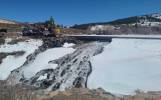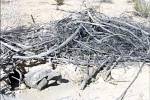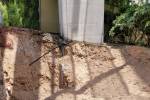How to protect concrete from winter damage
The average winter temperature in 25 U.S. states is below freezing, according to the National Climatic Data Center, and that can be very harmful to concrete surfaces left unprotected by homeowners. The repeated freezing and thawing that occurs due to changes in daytime and nighttime temperatures during the winter can cause concrete to crack and flake. Homeowners should repair and protect surfaces now to avoid costly projects in the spring.
When rain, snow or ice migrate through cracks and saturate the ground under the concrete, the concrete will shift and move every time freezing and thawing occurs. This repeated movement can cause the cracks to expand or create new ones. Concrete also acts as a rigid sponge that if left unprotected becomes saturated from rain, snow and ice during the winter. When temperatures drop below freezing, the water saturating the concrete expands and can cause the surface to flake. Fortunately, there are some simple projects, products and tips that can help homeowners prepare for these winter challenges.
Tips for repairing concrete cracks
* Use a flexible polyurethane sealant like QUIKRETE Polyurethane Concrete Crack Sealant that allows concrete to move and shift without the crack reoccurring.
* Widen existing cracks to minimum of 1/4-inch with a hammer and chisel, and clean debris from the crack with a brush. Then fill the crack with the sealant level to the surface using a standard caulk gun.
Tips for protecting concrete surfaces
* Clean the surface with a pressure washer and/or cleaner to remove all dirt, grease, salts and other bond inhibitors. Then apply a water-based acrylic sealer like QUIKRETE Concrete Cure & Seal using a garden sprayer, roller or brush to waterproof and protect concrete surfaces.
* Remove snow and ice from concrete surfaces using a shovel rather than deicers or rock salt whenever possible. If removal requires a deicer or rock salt, use the minimum amount required to avoid damage caused by chemicals in the products.
For more information, tips and how-to videos on protecting concrete during the winter, visit www.quikrete.com or look for QUIKRETE on Facebook.























